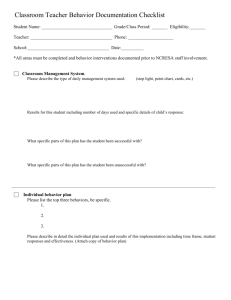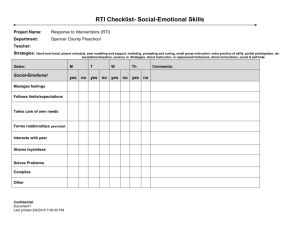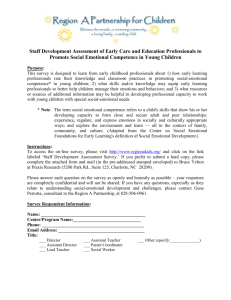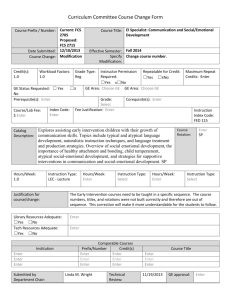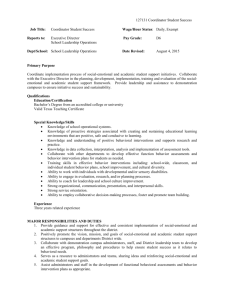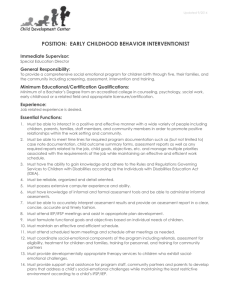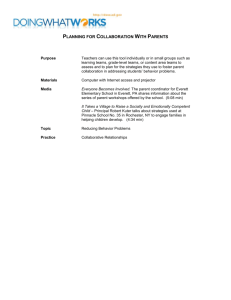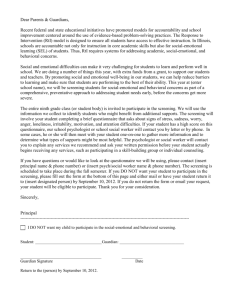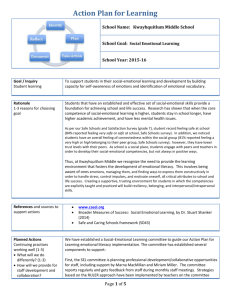Stephen Green, Ph.D. Supporting Children’s Social and Emotional Development.
advertisement
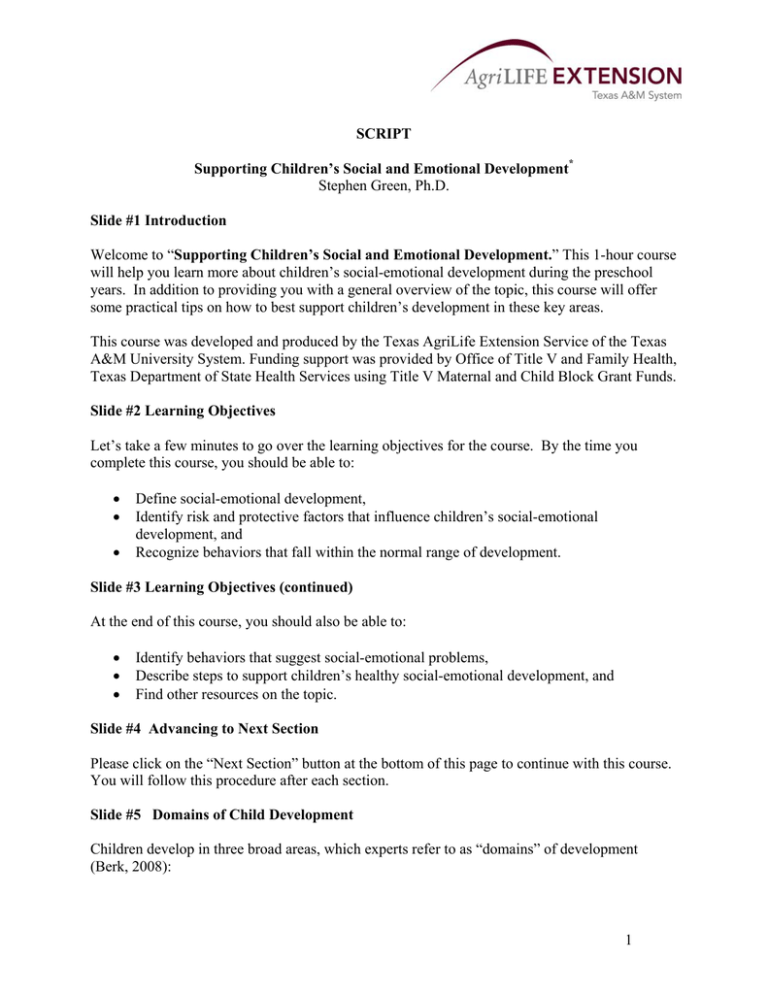
SCRIPT Supporting Children’s Social and Emotional Development* Stephen Green, Ph.D. Slide #1 Introduction Welcome to “Supporting Children’s Social and Emotional Development.” This 1-hour course will help you learn more about children’s social-emotional development during the preschool years. In addition to providing you with a general overview of the topic, this course will offer some practical tips on how to best support children’s development in these key areas. This course was developed and produced by the Texas AgriLife Extension Service of the Texas A&M University System. Funding support was provided by Office of Title V and Family Health, Texas Department of State Health Services using Title V Maternal and Child Block Grant Funds. Slide #2 Learning Objectives Let’s take a few minutes to go over the learning objectives for the course. By the time you complete this course, you should be able to: • • • Define social-emotional development, Identify risk and protective factors that influence children’s social-emotional development, and Recognize behaviors that fall within the normal range of development. Slide #3 Learning Objectives (continued) At the end of this course, you should also be able to: • • • Identify behaviors that suggest social-emotional problems, Describe steps to support children’s healthy social-emotional development, and Find other resources on the topic. Slide #4 Advancing to Next Section Please click on the “Next Section” button at the bottom of this page to continue with this course. You will follow this procedure after each section. Slide #5 Domains of Child Development Children develop in three broad areas, which experts refer to as “domains” of development (Berk, 2008): 1 • • • Physical development is the first domain. It refers to changes in the child’s body, such as size, shape, appearance, and functioning. Next, there is cognitive development. This refers to changes in a child’s intellectual abilities. Included are things such as learning, memory, reasoning, thinking, problem solving, and language development. Finally, the third area is social and emotional development. Sometimes it is referred to as early childhood or infant mental health. Slide #6 Social-Emotional Development Defined Social-emotional development refers to “a child’s developing capacity to: experience, manage and express the full range of positive and negative emotions; develop close satisfying relationships with other children and adults; and actively explore their environment and learn…” (Cohen, Onunaku, Clothier, & Poppe, 2005, p.1). This last definition is somewhat complicated. So, let’s talk about what it means in very practical terms. The “social” part of this definition refers to how children interact with others. This includes both children and adults. The “emotional” part refers to how children feel about themselves, others, and the world in general. Healthy social-emotional development begins early in life. For example, babies need to develop strong attachments to the important people in their lives. This includes their parents. However, it also includes you. You play a valuable role in helping babies feel safe and secure by providing warm and responsive care. When you hold, rock, talk, sing, play with and comfort babies, you are helping them develop the skills they need to form relationships with others and learn more about the world in which they live. You are also setting the stage to help them learn to recognize and express emotions. As children grow a little bit older, they begin to develop an awareness of their own emotions. They understand that others have emotions, too. For example, the 2 year-olds in your care begin to display more complex emotions. They have feelings like guilt, shame, embarrassment, and pride. Around this time, these same 2 year-olds develop a vocabulary for talking about their feelings and the feelings of others. This is where you can have a big impact. You can help these children learn to get along others and express their emotions in ways that promote their healthy social-emotional development. Slide #7 Principles of Development Let’s spend some time going over a few key principles of child development that will help us as we move forward in this course. One of the first principles of child development is that it is multidimensional. This means that development does not just occur in one area. The areas of development that we just discussed often overlap. What happens in one area can impact another. For example, when a child moves from the infant to the toddler stage, she becomes more mobile (physical development). She then is able to learn more about her immediate environment as she explores her surroundings 2 (cognitive development). At this stage, she will likely begin playing with other children. Playing with other children builds her social skills (social-emotional development). This simple example shows how the domains of development interact with each other. Slide #8 Principles of Development (continued) A second principle of child development is that it occurs in a predictable (orderly) sequence. There are always exceptions. However, children tend to follow certain patterns. For example, most children will roll over, sit up, crawl, and walk - all in this order. Children’s knowledge and skills are built up over time. This does not mean that all children will reach developmental milestones at the same time. Children are unique. They possess their own personalities, temperaments, learning styles, and family backgrounds. Charts that point out key developmental milestones are not meant to be viewed in a rigid manner. Rather, they provide us with an idea of what tends to happen with children at certain periods of time. Having said this, it could be a sign of a problem if children are not reaching certain milestones. In some cases, a pediatrician or specialist should be consulted. Slide #9 Principles of Development (continued) A third principle of child development is that it is impacted by early experiences. From birth to age 5, development happens at a quicker pace than any other stage of life. The child’s brain grows rapidly during these early years. This helps children gain the ability to think, speak, learn and reason. We’ve known for many years that the early years of a child’s life are very important. Recent research on brain development is shedding light on why these early years are so important. One of the things we’ve learned is that children’s early experiences can directly influence the physical structures in the brain. These structures impact lifelong learning. A healthy baby is born with about 100 billion brain cells. However, the brain is in an unfinished state. One of the most important things that occurs within the baby’s brain is forming connections between brain cells. During the early years of a child’s life, trillions of connections are formed – about 1,000 trillion by age 3! The child’s brain actually forms more connections than needed. Then a “pruning” process begins where the unused or faulty connections are removed. This is actually a good thing because the remaining connections are strengthened. The challenge for parents and other caregivers is to create an environment for children that helps reinforce important brain connections. How can you do this? Experts believe that the best way to promote healthy brain development is to provide young children with good quality care. When it comes to brain development, building warm, caring relationships with the children in your care is probably the best thing you can do for them. Children need to feel secure in their relationship with you. They need to know that they can trust you. You can build strong attachments to young children by consistently being there for them and by responding to their needs quickly and warmly. We’ll talk more about this later in the course. A recent study found that quality care in the early years from parents and other caregivers is linked to better outcomes for children. This includes: 3 • • • • Better social and thinking skills, Better language ability, Better math skills, and Higher levels of school readiness. The same study found that children who received high quality care also had fewer behavior problems. Slide #10 Principles of Development (continued) A fourth principle of child development is that it occurs in a broader social and cultural context. You have a very strong influence on the children in your care. However, there are other influences that shape how a child will grow and develop. Families, educational settings, communities, and the larger society all influence children. These influences can be either positive or negative. For example, we know that children who grow up in abusive home environments have difficulty in other areas of life. This includes forming relationships with other children and adults. Slide #11 Principles of Development (continued) A fifth basic principle of child development is that it depends on both genes and environment. Today, experts agree that child development depends on our genetics and the environment in which we live. Genes set limits on certain aspects of development. Examples include height, weight, and other physical characteristics. What about the environment? The environment influences the entire process of development. A few examples include prenatal nutrition, quality of relationships with primary caregivers, family structure, and neighborhood safety. While you might not have much influence on a 3 year-olds’ hair or eye color, you can help aid his healthy development by forming a good relationship with him and his parents. Slide # 12 Benefits of Healthy Social-Emotional Development Let’s review once again the definition of social and emotional development. It refers to “a child’s developing capacity to: experience, manage and express the full range of positive and negative emotions; develop close satisfying relationships with other children and adults; and actively explore their environment and learn…” (Cohen, Onunaku, Clothier, & Poppe, 2005, p.1). There are many benefits of healthy social and emotional development for children. Children who experience healthy development in these areas are more likely to: • • • • • form stronger relationships with other children and adults, succeed in group settings, have higher levels of confidence and self-esteem, develop the ability to concentrate and learn, communicate thoughts and feelings in appropriate ways, 4 • • • • control and express the full range of human emotions, successfully resolve conflict, be ready for school, and experience academic success. Young children who fail to achieve important social and emotional milestones are much less likely to succeed in school. As a result, they are at a higher risk for school failure and a host of other problems as they grow older. Slide #13 Characteristics of Emotionally Healthy Children Many child development experts are now pointing out the important role of emotions in children’s development. The National Scientific Council on the Developing Child (2005) made the following statement about children’s emotional development, “The core features of emotional development include the ability to identify and understand one’s own feelings, to accurately read and comprehend emotional states in others, to manage strong emotions and their expression in a constructive manner, to regulate one’s own behavior, to develop empathy for others and to establish and sustain relationships.” What do you think this would mean for the average 2 year-old in your care? He’s now beginning to understand how his actions impact the feelings of others. For example, when he takes a toy away from the boy sitting next to him, and the boy starts to cry, he understands that the boy is upset because of something he did. He is starting to relate to the emotions of others and can even show occasional empathy. He can recognize the basic emotional expressions of others (e.g., happiness, anger, sadness). Even though he won’t be able to control his emotions all the time, he can now show some self-control. After you talk to him about taking things from others, he might even think twice before taking away a toy from a child the next time. Emotions play a big part in all aspects of children’s lives. Experts believe that emotionally healthy children share a common set of characteristics. These include*: 1. 2. 3. 4. 5. Warm, trusting, close relationships with other children and adults Positive self-esteem Good impulse control and behavior management The ability to separate make-believe from reality A rich imagination. This includes the ability to use words to express needs, feelings, and ideas. 6. Empathy and compassion for others, and 7. The ability to concentrate, focus, and plan as a basis for learning in educational settings Slide #14 Risk and Protective Factors that Influence Children’s Social-Emotional Development 5 Children’s social-emotional development is influenced by many factors. These factors fall into two categories: risk factors and protective factors. Risk factors are those things that can challenge children’s healthy social-emotional development. Protective factors, on the other hand, are those things that help children adjust to difficult circumstances. Protective factors also guard children from challenges to their healthy social-emotional development. Let’s begin by identifying some of the key risk factors. We will then move on to a discussion of the protective factors. Slide #15 Risk Factors We know that families may face many challenges. Some of these challenges can negatively impact a child’s healthy social and emotional development. Some of the factors that put children at risk include: • • • • • • • • • • • • • Lack of a secure attachment with a primary caregiver(s) Family stress Parental depression or other mental illness Poverty Malnutrition Parental substance abuse Abuse and neglect Homelessness Community or family violence Exposure to toxins Military deployment of a parent Death or loss of a family member Poor quality child care You probably noticed that many of these risk factors overlap. For example, poverty can lead to many other problems (e.g., homelessness, family stress, lack of access to quality child care, etc.). To help children, risk factors should be minimized and protective factors should be maximized. Slide #16 Protective Factors We’ve just considered several risk factors. Let’s now consider some important protective factors. Some of the most important protective factors include: • Secure attachments with parents and other caregivers • Positive parenting practices. Examples of positive parenting practices include: o Unwavering love, o Being sensitive to a child’s needs and feelings, o Clear and consistent limits in line with a child’s stage of development, o Firm but not harsh discipline, o Encouragement of child’s emerging independence, o Parental involvement in child’s education, and 6 o Being a positive role model. • A stable home environment. This includes (among other things) having sufficient financial resources, not being exposed to domestic violence and drug and alcohol abuse, and living with parents in a low-conflict marriage. • High quality non-parental child care environments One of the things that all of these protective factors have in common is a good relationship between the child and the important adults in his or her life. Strong parent-child and caregiverchild relationships can act as a buffer (protection) against some of the risk factors that we discussed. When you develop a strong attachment to the children in your care and provide care that is consistently positive, you contribute in many ways to a child’s healthy social-emotional development. In fact, it has been found that you can have a positive impact on a child’s socialemotional development even when the parent-child relationship is under stress. You are in an important position to help parents learn more about their children’s socialemotional development. By talking to them about their children, you can help parents build better relationships with their children. You can even offer them some specific tips on how to promote their children’s social-emotional development. In a few minutes, we’ll take a look at some simple things that can be done to support children’s development in these areas. Slide #17 Characteristics / Features of High Quality Child Care As we just discussed, high quality non-parental child care is a valuable protective factor for children. What is high quality child care? Early childhood experts have found that the following features are associated with higher quality care: • • • • • • • • • small group sizes with high staff-to-child ratios; low staff turnover rates; a well-educated staff who have received specialized training in child development; programs that have undergone a licensing and/or accreditation process; an age appropriate physical environment that provides children with opportunities for safe and enjoyable indoor and outdoor play; programs that involve children in a wide variety of activities that promote development in multiple domains (i.e., physical, social-emotional, and cognitive); a family friendly environment that encourages regular parental involvement; programs that promote the health and safety of children, including proper nutrition and food safety practices; and warm and responsive caregivers who meet the needs of each child. We will refer back to some of these elements later in the course as we discuss what you can do to support children’s social-emotional development. Slide #18 Social-Emotional Behaviors Within and Outside the Normal Range We discussed earlier how development tends to follow a predictable course. This holds true for all three broad areas of development. However, some children have trouble when it comes to 7 healthy social-emotional development. This is often due to being exposed to too many risk factors. It is important to be able to identify child behaviors that suggest social-emotional problems outside the normal or expected range. In the next several slides, we’re going to discuss some typical social-emotional developmental milestones. Then, we will focus on some behaviors that fall outside of the norm. Slide #19 Social-Emotional Behaviors within Normal Range (Birth to 12 months) During the period from birth to 6 months, infants smile and laugh a lot. Their emotional expressions become well organized. They demonstrate an awareness of self as distinct from their surroundings. They also begin to develop trust as they interact with primary caregivers (e.g., parents, child care providers). From 7 to 12 months, infants become more mobile. They begin to show other emotions. Among these are anger and fear. It is common for children at this stage to show stranger and separation anxiety. They can detect the meaning of others’ emotional expressions. Infants at this stage also demonstrate clear attachment to a primary caregiver. Slide #20 Social-Emotional Behaviors within Normal Range (13-24 months) From 13 to 18 months, young children begin to recognize an image of themselves in a mirror. You will begin to see signs of empathy emerge. Children within this age range can obey simple requests and commands. While play is an extremely important part of their lives, it tends to be solitary at this stage. By the time children reach 19 to 24 months, they begin to show a wider range of emotions. This includes shame, embarrassment, guilt, and pride. It is around this stage that young children tend to develop a vocabulary for talking about their feelings and the feelings of others. They are able to use their own name to label themselves. They also begin to show greater self-control over their own behaviors. Finally, they are able to group themselves and others based on age, sex, and physical characteristics. Slide #21 Social-Emotional Behaviors within Normal Range (2-4 years) Two year-old children develop a concept of self (self-esteem). They begin to cooperate with other children and adults to a certain extent. However, aggression also appears at this stage. Two year-olds are able to understand causes and consequences. Empathy increases. So do gender-stereotyped beliefs and behavior. During the 3 to 4 year-old period, children have better control over their emotions. Cooperative play (i.e., play with others) improves. They begin to form their first friendships. During this stage, children will sometimes share. However, they tend not to share well. Slide #22 Social-Emotional Behaviors within Normal Range (5 years) 8 By age 5, some children are enrolling in kindergarten. Others are not. At this stage of development, children engage in pretend/dramatic play. However, they also exclude other children during play. They still may confuse fantasy with reality. Five year-olds are fearful of certain situations and people. They can take turns and share, but don’t always like to. They like to test their muscular strength and motor skills, but more often than not, are not emotionally ready for competition. Finally, they seek adult approval and have a basic understanding of right and wrong. Slide #23 Behavioral Warning Signs Suggesting Social-Emotional Difficulties Outside Normal Range You have a good idea of what to expect from infants, toddlers, and preschoolers. Let’s now turn our attention to some warning signs that might suggest social-emotional problems. We will divide children into two groups: 1) infants and toddlers (birth to age 3), and 2) preschoolers (ages 3 to 5). Infants and Toddlers Some warning signs to look for in infants and toddlers include: • • • • • • • • • • • • • Shows very little emotion. An example of this would be a baby in your care who doesn’t make eye contact, smile, or cry. Does not show interest in sights, sounds, or touch Rejects or avoids being touched or held Inconsolable “fussiness” or irritability (unusually difficult to soothe) Unable to comfort or calm self Extremely fearful. For example, a toddler may show great fear of separating from you or another primary caregiver. He may cling, cry, and even through tantrums when faced with the possibility of leaving your presence. Shows sudden behavior changes Excessive hitting, biting and pushing of other children Inability to establish relationships with other children or adults Inability to adapt to new situations Extreme upset when left with another adult Easily startled or alarmed by routine events Chronic feeding or sleeping difficulties Slide #24 Behavioral Warning Signs (continued) Behavioral warning signs to look for in preschoolers include: • • • • Unable to play with others or objects Absence of language or communication Frequent fights with others (aggressive or impulsive behavior) Extreme sadness 9 • • • • • • • • Extreme mood swings Unusually fearful Loss of earlier skills (e.g., toileting, language, motor) Sudden behavior changes Destructive to self and others Withdrawn (shows little interest in interacting with other children) Engages in compulsive behaviors (e.g., head banging) Throws wild, despairing tantrums Please keep in mind that occasional behaviors rarely mean a serious problem. Rather, you should be looking for patterns in behavior over time. For example, it is common for a young child to throw a temper tantrum every now and then. However, if these tantrums become more frequent or harmful to the child or others, you should take further action to find out the root cause. Slide #25 What to Do When Behavior Problems Persist The National Training Institute for Child Care Health Consultants suggests that caregivers should do the following to find out more about a problem behavior: • • • • Observe and document the child’s behavior over time and in a range of different relationships, environments, and activities. Have a coworker or supervisor observe the child to provide a different view of the problem. Express concerns to the child’s parents. Work together with them to understand the behavior. Develop strategies to better meet the child’s needs. With the parent’s consent, ask a mental health consultant to observe and assess the child. This person can give ideas on strategies to support positive behavior or for intervention. Parents might also request this. Slide #26 What You Can Do to Support Children’s Social-Emotional Development We looked at some features of high-quality child care programs earlier in the course. Many of these features have to do with the relationships that you have with the children in your care. They are also related to the type of environment that you provide for them. Relationships and the environment have a major impact on children’s social-emotional development. We will now look at some practical things you can do to support the social-emotional development of the children in your care. Treat each child with warmness and respect. Strong caregiver-child relationships are formed over time as a result of consistent positive interactions. Make an effort to treat each child in your care with kindness and respect. This should be done regardless of the child’s gender, ethnicity, or family background. Children need to feel loved and respected by the adults in their lives. You can show this love and respect by interacting with children in a warm and nurturing manner. Some actions you can take include: • Warmly greet children when they arrive. 10 • • • • • • Comfort, touch, hold, rock, sing, and talk to infants regularly. Hug children as they arrive and depart your center or family child care home. Pat children on the back when they have done a good job. Maintain eye contact with children when talking to them. Smile often. Watch your tone of voice when talking with the children. Slide #27 What You Can Do (continued) Be responsive to children’s needs. Responsive care means matching your caregiving style to what the children need. This is important for children of all ages, but especially for infants and toddlers. Things you can do to be responsive include: • • • • • Create safe and predictable routines. Doing this helps children feel safe, secure, and comfortable with you and the child care environment. Quickly respond to infants when they cry. Comfort children who are in distress by providing prompt support and assistance. Think about the meaning of children’s behavior so that you can respond in the best way. Communicate regularly with parents in order to learn more about their children’s needs. Slide #28 What You Can Do (continued) Create a positive emotional climate. The emotional climate in the child care setting is very important. You play a big role in making sure the climate is positive. Both your verbal and nonverbal behaviors influence how children feel about the classroom. Some ways that you can create a positive emotional climate include: • • • • • • • Make sure that children enjoy coming into your classroom in the morning. Ensure that children feel safe and secure. Create a physical environment that helps children learn. Keep conversations pleasant (to the extent that you can). Hold realistic expectations for the children in your care. Pay attention to your non-verbal behavior (i.e., does it convey that you are happy to be in the classroom?). Encourage children to express their emotions in appropriate ways. Slide #29 What You Can Do (continued) Make it a priority to get to know each child on an individual basis. Every child in your care is special. They have unique talents, abilities, and preferences. They also have unique temperaments, family histories, and cultures. When trying to form a trusting and healthy relationship with each child, it is important to do the following: • • Engage each child in one-on-one conversations on a regular basis. Listen to each child’s opinions. 11 • • • • • Seek to learn more about a child’s likes and dislikes. Attempt to get to know the child’s family. Seek to understand the child’s cultural background. Consider each child’s unique needs, interests, learning style, and abilities. Regularly evaluate each child’s progress and vary your interactions accordingly. Slide #30 What You Can Do (continued) Talk to children about their feelings. One of the most important predictors of children’s development is the language used by the caregiver. As you think about the interactions you have with children, try these things: • • • • • Use language to describe feelings and experiences. Acknowledge children’s feelings. Teach children to identify their various emotions (e.g., anger, sadness, fear, happiness, etc.) Read and discuss books about feelings. This also includes the best ways to express them. Encourage children’s emotional self-regulation. This refers to a child’s ability to control emotions and impulses. Slide #31 What You Can Do (continued) Help children learn to resolve conflict in a healthy way. Young children (toddlers in particular) have a difficult time sharing, turn taking, and following rules. Their limited social skills can increase the chances for conflict with other children. You have many opportunities to help children learn problem solving skills that will benefit them now and in the future. Try the following tips from Zero to Three:* • • • • Keep it simple. Explain the situation in as few words as possible. Remain calm and do not use an angry voice. Go over what happened to make sure the children understand what has just happened. For example, “You hit Jill because she took your crayon.” Point out the consequences of the child’s behavior. “After you hit Jill, she started to cry. It hurt. She felt sad and mad.” Brainstorm better choice(s) the children can make the next time. Older children will be able to come up with some ideas on their own. However, younger children will need you to offer some suggestions. Most children will need you to help them carry out what has been discussed. Slide #32 What You Can Do (continued) Use guidance & discipline strategies that are appropriate for the age of the child. The most effective style of discipline is an authoritative one. Authoritative caregivers balance control and strictness with warmth and flexibility. Children thrive when caregivers are firm and demanding, yet warm and caring. Try the following actions: 12 • • • • • • • Take into account the age, developmental stage, and temperament of each child. Seek to understand the reason(s) for the behavior. Communicate your expectations for children’s behavior clearly and directly. Hold children responsible for their behavior. Be consistent. Give consequences for negative behavior in a fair and consistent manner. Be firm, yet loving toward the children in your care. There are many factors associated with quality child care. However, none is more important than the way in which you interact with the children in your program. When you interact with children in a warm, respectful, and encouraging manner, you establish an environment that benefits children now and in the future. Slide #33 Conclusion This concludes the informational portion of this course. Please click on the “Next Section” button at the bottom of this page to proceed to the post-test. If you would like to review any of the previous sections, click on the desired title in the left menu bar. References Berk, L. E. (2008). Exploring Lifespan Development. Boston, MA: Pearson. Boyd, J., Barnett, S.W., Bodrova, E., Leong, D.J., & Gomby, D. (2005). Promoting Children’s Social and Emotional Development through Preschool Education. National Institute for Early Education Research. Available online: www.nieer.org. California Childcare Health Program (2006). Social and Emotional Development of Children. California Training Institute. Available online: http://www.ucsfchildcarehealth.org/pdfs/Curricula/CCHA/15_CCHA_SocialEmotional_0406_v2 .pdf. Center on Social and Emotional Foundations for Early Learning http://www.vanderbilt.edu/csefel/. Cohen, J., Onunaku, N., Clothier, S., & Poppe, J. (2005). Helping Young Children Succeed: Strategies to Promote Early Childhood Social and Emotional Development. Early Childhood Research and Policy Report. National Conference of State Legislatures. Available online: http://www.ncsl.org/default.aspx?tabid=16339. Longaker, C. (2006). The Emotionally Healthy Child at Age Three or Four. In California Training Institute’s California Childcare Health Program – Social and Emotional Development of Children. 13 National Association for the Education of Young Children (2009). Developmentally Appropriate Practice in Early Childhood Programs Serving Children from Birth through Age 8. Position Statement. Available online: http://www.naeyc.org/files/naeyc/file/positions/position%20statement%20Web.pdf. National Center for Early Development & Learning (1997). Quality in Child Care Centers. Early Childhood Research and Policy Briefs, 1(1). Frank Porter Graham Child Development Center. National Institute of Child Health and Human Development (2006). The NICHD Study of Early Child Care and Youth Development: Findings for Children up to Age 4 ½ Years. Available at http://www.nichd.nih.gov/health/topics/seccyd.cfm. Oesterreich, L. (2001; 2004a; 2004b; 2007). Ages and Stages (3-Year-Olds; 4-Year-Olds; 5Year-Olds; 6-8 Years). Iowa State University Extension. The University of Maine (2007). Friends and Feelings: Social-Emotional Development in Young Children. Available online: http://www.ccids.umaine.edu/ec/growingideas/. ZERO TO THREE www.zerotothree.org. * This course was developed and produced by the Texas AgriLife Extension Service of the Texas A&M University System through funding support was provided by Office of Title V and Family Health, Texas Department of State Health Services using Title V Maternal and Child Block Grant Funds. Educational programs of the Texas AgriLife Extension Service are open to all people without regard to race, color, sex, disability, religion, age, or national origin. The Texas A&M University System, U.S. Department of Agriculture, and the County Commissioners Courts of Texas Cooperating 14
